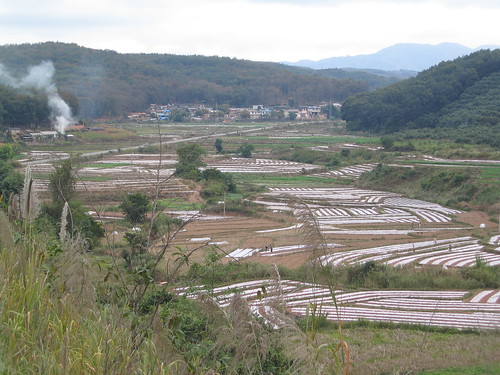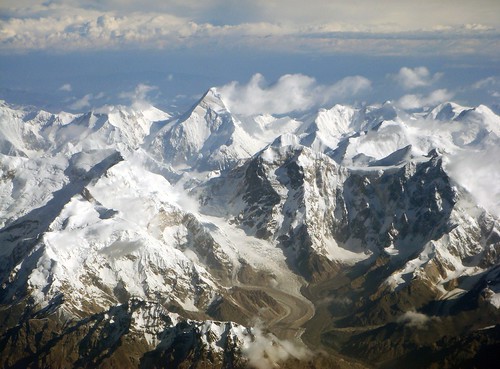Chinese Place Names in the Hyperion Cantos
It’s been a few weeks since I finished Dan Simmons’ sci-fi classic quadrilogy, the Hyperion Cantos. It was a great story, full of grand sweeping ideas, and one thing that got my attention was the repeated use of Chinese names (especially in Book 4).
Anyone studying Chinese might be a little thrown off by the use of the (mostly) Wade-Giles transcription instead of pinyin, but the names are all right out of Chinese history and geography (with a few errors).
Here’s a list of all the major ones I caught, with notes following (please leave a comment if I’ve missed anything):
| Hyperion | Pinyin | Characters | Notes |
| Tsingtao-Hsishuang Panna | Qīngdǎo-Xīshuāngbǎnnà | 青岛西双版纳 | [Notes] |
| T’ien Shan | Tiān Shān | 天山 | [Notes] |
| Hsuan-k’ung Ssu | Xuánkōng Sì | 悬空寺 | [Notes] |
| Hua Shan | Huà Shān | 华山 | [Notes] |
| Heng Shan | Héng Shān | 衡山 / 恒山 | [Notes] |
| T’ai Shan | Tài Shān | 泰山 | [Notes] |
| Sung Shan | Sōng Shān | 嵩山 | [Notes] |
| O-mei Shan | Éméi Shān | 峨眉山 | [Notes] |
| Chiu-hua Shan | Jiǔhuà Shān | 九华山 | [Notes] |
| Wu-t’ai Shan | Wǔtái Shān | 五台山 | [Notes] |
| P’u-t’o Shan | Pǔtuó Shān | 普陀山 | [Notes] |
Tsingtao-Hsishuang Panna
It seems odd to bring together the city of Qingdao (青岛) and the southern region of Xishuangbanna (西双版纳) into a name for a planet. In fact, the only way they make sense in my mind is drinking a Tsingdao (beer) in Xishuangbanna (a touristy region of Yunnan Province). Maybe that’s Simmons’ little secret for this planet?
T’ien Shan
Tian Shan (天山) is actually a system of mountains, so it makes sense to use as a name for a mountainous planet. It’s also got a nice picturesque name, meaning “mountains of heaven.” Those of us the live in Shanghai might recognize it from the street name: 天山路.
Hsuan-k’ung Su
Normally referred to as the “Hanging Temple” in English, this fantastical Buddhist structure is a real thing, located in China’s Shanxi Province.
Hua Shan
Hua Shan (华山) is one of China’s “Five Great Mountains,” so it’s an obvious candidate for inclusion. Interestingly, at one point in Rise of Endymion the mountain is referred to as “Flower Mountain” (花山), but this is almost certainly a mistake based on similar romanization, considering that there are no obvious candidates from the list of possible 花山s in China, and pretty much all the other mountains listed can be found on this list of the “Sacred Mountains of China.” (There’s another Shanghai street name here too.)
Heng Shan
I’m not sure whether Heng Shan refers to 衡山 or 恒山; both are in the list of “Give Great Mountains,” and the pinyin (including tone) is identical. I’m assuming Simmons wisely used one “Heng Shan” for both.
T’ai Shan
Tai Shan (泰山) is another of China’s “Five Great Mountains.”
Sung Shan
Song Shan (嵩山) is another of China’s “Give Great Mountains.”
O-mei Shan, Chiu-hua Shan, Wu-t’ai Shan, P’u-t’o Shan
The mountains Emei Shan (峨眉山), Jiahua Shan (九华山), Wutai Shan (五台山), and Putuo Shan (普陀山) are China’s Four Sacred Mountains of Buddhism, so they’re also easy choices. The “flower” translation mistake happens again with 九华山 at one point, and as I final question, does anyone else see “Chiu-hua” an think, “chihuahua”?
It’s cool to see a Western author drawing on Chinese names in his world-building, and before you cry “Pander Express!” keep in mind that these novels came out in the 90’s.
Feel free to leave a comment if I missed something or you have something to add.
Related Links:
– Hyperion Cantos Wiki
– Hyperion Cantos on Amazon








The Hua- (华) in Hua Shan actually does mean flower, as it supposedly resembles a lotus (华 and 花 used to be used interchangeably), so Simmons actually got this one right! (See, for example, http://www.zdic.net/c/e/16/35653.htm).
And do you see any other Chinese influence in these books aside from Chinese names?
I dunno; “Flower” (or “Flowery”) wouldn’t be a totally crazy rendering of 华 — it’s cognate to 花 and its meaning derives from the sense of “flowery; in full bloom.” Brian Holton’s ongoing Scots translation of Shuihu zhuan renders it as “Mount Glore,” I think, and I think “Mount Glory” could probably work.
You’re right about “Tsingtao-Hsishuang Panna” being weird — it’s a mix of two romanization systems (Postal and Wade-Giles), and the second one is wrong (it should be “Hsi-shuang Pan-na” if we’re keeping that spacing) and is not actually a Chinese placename in any event. (It’s a transliteration of the Dai name Sipsongpanna.)
Still, this is the kind of error that I can live with in my science fiction — unlike, e.g., the unaccountably popular Firefly/Serenity, which gave off powerful waves of “we didn’t care about this” every time the characters accessorized with poorly translated and egregiously mispronounced Chinese. Seriously, screw that show and everyone who ever recommended it to me.
(Also: typo in your Wade-Giles above: the heading should be “Hsuan-k’ung Ssu,” not “Hsuan-k’ung Su.” Actually it should technically be “Hsüan-k’ung Ssu,” but I’ll let it slide just this once.)
As mentioned by other commenters, in old Chinese, “華”=”花”. According to the Chinese wiki page for Hua Shan, it was so named exactly because people back then thought this mountain looks like a flower. Also, the interchangeability between 華 and 花 remains in modern Japanese which imported these characters before their meanings differentiated.